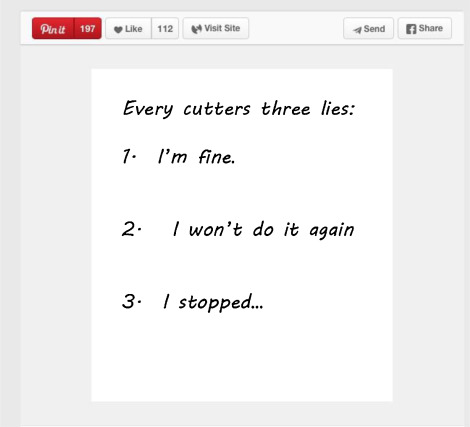In my recent posts for this blog, I have looked at the portrayal and discussion of mental health in the context of several different media platforms. Here, I review the findings of a recent paper that reveals how users of the visual, idea-collaging platform Pinterest are sharing experiences of and advice about depression. 
Continuing with the theme of media and its responsibility towards spreading awareness about mental health, I recently found myself learning more about a social media platform that has become something of an unlikely frontier for this issue. Pinterest is a website that combines the visuals of Instagram photos, with the convenient linking to external websites that we find on Twitter, paired with the addictive “infinite scroll” code from Facebook that prevents us from ever reaching the bottom of our feed. It aims to virtually simulate the process one would go through when making an ‘inspiration board’, allowing users to collate images, websites links, and quotes into their respective virtual pin boards.
It has naturally become a mecca for visual organizers like myself, who take comfort in knowing that everything we see and experience on the internet can be saved into respective folders (in my case these folders consist of food, travel and a collection of 2016’s best memes). Pinterest posts, simply referred to as “pins,” range from decorative DIY ideas, to workout tips and cleaning hacks, all of which are presented through brightly colored, aesthetically pleasing images.
A website that seems, for its majority, to focus on Mason jar crafts was therefore not the first social media platform that came to mind when it came to investigating representation of mental health online. However, I stumbled across a recent study on portrayals of depression on Pinterest. In fact, it seems users are taking advantage of the Pinterest format of quotes and “easy tips” to start speaking about mental illness at large. It is, of course, worth looking deeper into the content of such usage, given the importance of something as serious as depression being handled responsibly – especially on a website that boasts over 100 million users.
The researchers in the study aimed to answer five global questions, among them: how depression is portrayed, how users respond to this portrayal, and what kind of coping methods, if any, are suggested. They obtained a sample of 783 pins by searching keywords related to depression (e.g. “clinical depression”), and selecting to code every fifth pin on the page for randomization. Pins were coded for their stance (positive, negative or neutral), their severity (mentions perceived high-severity or actual high severity), the response they received (how many likes, re-pins or comments), how many mentioned suicide or self-harm, and what types of depression-related coping methods were proposed (problem-focused, emotion-focused, dysfunctional or no coping).
“Pinterest thrives as a popular network for its users because it remains a safe place for self-expression and honesty – including around the distress of mental illness – and this freedom should not be restricted”
The results showed that in the majority of cases, the stance of the pin was negative (48.7%) and was more likely to refer to the perceived severity of depression (54.8%) as opposed to its actual severity. It was also found that almost one in every 10 pins had a mention of suicide, and almost 7% made a reference to self-harm or cutting specifically. Only 40% of pins suggested a coping method, but the majority of the proposed coping methods (55%) were determined to be dysfunctional. These dysfunctional methods included advice encouraging or condoning avoidance, self-blame, denial, and behavioral disengagement. These results therefore seem to leave Pinterest in an unfavorable position, as the website has evidently become a platform for unhealthy information about depression.
Despite these results, the study has at least established that Pinterest is in fact a website where mental health is being discussed. Pinterest thrives as a popular network for its users because it remains a safe place for self-expression and honesty – including around the distress of mental illness – and this freedom should not be restricted. However, allowing negative pins about depression and self-harm to be constantly repinned and shared is, in some ways, a form of validation. It is for this reason that the researchers suggest the best way forward is for health organizations to start being active on the Pinterest sphere.
Only 3.7% of pins were found to have originated from health organization websites, leaving 86.3% of pins to have originated from non-medical organizations, online blogs, or simple Pinterest user accounts. The researchers therefore argue that ensuring practical, qualified advice is provided to those in need begins with the greater presence of reputable organizations dispensing this advice. It is important to feel you can express your thoughts freely online, but it is equally crucial to have access to a proper support system and information about ‘healthy’ coping methods to contribute to ameliorating your mental health.
The Pinterest-depression study reference is:
Guidry J, Zhang Y, Jin Y, & Parrish C (2016). Portrayals of depression on Pinterest and why public relations practitioners should care. . Elsevier Inc. Public Relations Review 42, 232–236. http://dx.doi.org/10.1016/j.pubrev.2015.09.002


